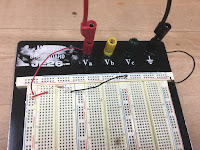Not Shocking People: Lesson 1
Week 1
1. What is the class format? The class is set up over three days: Monday, Wednesday, and Friday.
Monday:
Class starts discussing the take home quiz assigned the previous Monday. The lab for that week is then discussed with the class, led by Professor Tolga Kaya, from which the students separate into their separate groups of two and begin work on the lab till the end of class, during such time work stations are cleaned up and work is wrapped up.
Wednesday:
The class spends this day working on the lab discussed on Monday.
Friday:
This day is spent discussing and commenting on each groups blog.
2. What are the important safety rules?
For arguments sake, there will be a few named as the most important:
- When working with an experiment or project, there must be no power applied while it is being assembled or dissembled, and all high voltage points must be discharged to ground with an insulated jumper.
- Do not work alone when working with energized equipment.
- Do not simultaneously touch two pieces of equipment.
- Do not wear accessories that have metal components(i.e. ring, watch).
- If standing on a damp or metal floor or have wet hands, do not touch electrical equipment.
- Know where the fire extinguisher, med kit, and phone are in case of emergencies.
3. Does a circuit kill?
Yes, a circuit that has a current between 0.1 to 0.2 Amperes will kill. Current above 0.2 have the potential to kill but will more likely lead to severe burns and respiratory failure(stop breathing), which can both lead to death.
4. How do you read color codes?
5. What is the tolerance?
Tolerance is a measure of the variation from a specified value given on a piece of equipment. For example,
6. Prove all your resistors are within the tolerance range.
The represented resistance in the color code compared to the measured resistance, and the actual deviation of the measured value compared to the represented value.
7. What is the difference between measuring the voltage and current using a DMM? Why?
Apart from needing the positive lead being placed in a separate input when measuring current or voltage, when measuring voltage through a resistor, the leads must be placed on both ends of a resistor while the circuit is live. However, when measuring current, one must disconnect power and break the circuit, connecting one lead to each end of the break, removing hands, and turning on the power supply.
8. How many different voltage values can you get from the power supply? Can each one of them be changed to any value?
You can supply three different voltage values at one time with the power supply provided in Professor Kaya's class. Two of the supplies, the ones labeled A and B, can be changed from 0V to 25V.
9. Practice Circuit Results
Voltage measurement
10. How do you experimentally prove Ohm's Law?
 Ohm's Law: V=I*R => R=V/I
Ohm's Law: V=I*R => R=V/IWith the resistance predicted to be a fairly constant value, the idea is that as we increase the voltage , the current should go up proportionally, meaning that according to Ohm's law, the resistor value never changes.
We measured the current of a circuit using two resistors at five different voltages. The idea is that the current will rise as the voltage does, making it so that the calculated resistance stays the same. As you can see by our measurements, the current does increase, and when seeing the calculated resistance values, the resistance remains within tolerance.
11. Rube Goldberg circuit
12. Draw the circuit diagram for the Rube Goldberg machine set-up.
(Made using Digi-Key)






i think your blog is organized well. so it is a good start.
ReplyDeleteYour group provide a good amount of photos and some good explanations. Good job on the table also.
ReplyDeleteGroup 7
ReplyDeleteYour blog has a really good details but it is missing important information in some questions(question 10 needs to be added more information). other than that, your work is great.
I liked how detailed your diagrams are, and the detail you put into your lab report.
ReplyDeleteThis comment has been removed by the author.
ReplyDeleteNice use of Digi-Key to make your circuit diagram!
ReplyDeleteBe consistent on captions. Other than that it is a very nice blog. Citing Digikey was a nice touch. Nice tables.
ReplyDelete